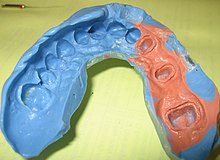Impression taking (medicine)

The impression is a work step in dentistry and defect prosthetics . In this case, by molding or casting a negative mold of a body areal (for example the alveolar process of a jaw or amputation stump prepared) which then in turn by filling with a suitable material (for example, plaster leads) to a positive of the molded area, so a copy of the form, including Called "model". Defect prostheses or on such models, for example, dentures made, or they are used for diagnosis or therapy - planning .
In dentistry, the terms “impression” and “impression” are often used synonymously , although, strictly speaking, the impression is the result of the impression.
Theoretical foundations
It is necessary to use a material for the impression, which on the one hand can cling to the surface of the area to be molded, on the other hand, after the end of the contact - especially during any transport and further processing - retains the shape assumed. To this end, provide thermoplastic and thermosetting materials and solidifying liquids at.
The separation of object and impression should be non-destructive for both. This often results in problems when the area to be molded has undercuts, that is, the impression material not only covers the structure to be molded, but also surrounds it. Therefore, impression materials should have at least limited elastic or elastomeric properties.
In order to be as accurate as possible, the impression material must offer as little resistance as possible to any change in its surface shape during the impression. In order to be able to transfer the shape assumed as precisely as possible to the model, it must offer as much resistance as possible to a change in its surface shape after the impression. These contradicting requirements can usually only be achieved at the cost of a profound chemical or physical change in the material. Such changes are often accompanied by a change in volume , which impairs the conformity of the impression with the molded area and is therefore undesirable. The fact that the desired properties of the impression materials often mutually exclude or at least reduce one another (e.g. drawing accuracy and volume stability) have led to relatively complex processes in impression-taking, through which various influences are to be largely neutralized.
Impression materials
When taking an impression, the main material groups used are alginate , hydrocolloid , silicone , polyether , plaster of paris or wax .
Molding methods
Free procedures
In free processes, materials are used that are stable enough after hardening to be transported and processed without any problems. An example of this is the classic face molding with plaster of paris, as it was used to produce half busts or death masks: Liquid plaster of paris is applied to the face of the object. After hardening, the plaster template can be removed and reused.
Carrier process
Since not all impression materials are as stable as plaster of paris after hardening, further measures are required in order to be able to use less stable materials.
Primary carrier
For this purpose, stable carriers are used for the impression material, which are called "impression trays" in dentistry. The impression tray is filled with the impression material. In addition, (special) material can also be applied directly to the area to be taken, usually a thinner flowing material, which then ensures a particularly exact impression through the "stamp pressure" of the harder impression material (double-mix impression). After the setting process, the tray and impression material are removed together.
Impression trays can be made up or individually. Processes in which prefabricated trays are used are correction impressions and double-mix impressions .
If individual trays are to be used, a situation impression must first be taken with a prefabricated tray. After a situation model has been produced, an individual tray can then be produced.
Secondary carrier
In the impression process with a secondary carrier, the timing is reversed as in the case of individual impressions: First, an elastic impression material that is accurate to the drawing is applied (usually alginate), into which retention bodies ( e.g. paper clips ) are inserted during the setting process, which after the curing process has been completed Protruding impression material. Then a stabilizing material (usually plaster of paris) is applied to the cured impression material, which after setting allows both layers to be removed without deformation and further processed.
"Optical" impression
Modern CAD / CAM processes in dentistry ( e.g. Cerec ) do without the physical impression of the treated tooth by creating a virtual image after optical detection of the tooth, on which dental prostheses are then planned using CAD and then manufactured using CAM. The optical scanning of the stump is therefore also called "optical impression".
See also
Individual evidence
- ↑ N. Schwenzer (Ed.): Dental materials science. Volume 3: Prosthetics and Materials Science. Thieme, Stuttgart / New York 1982, ISBN 3-13-593601-5 , p. 44 ff: Impression materials
- ↑ Klaus M. Lehmann, Elmar Hellwig: Zahnärztliche Propädeutik . 10th edition. Urban & Fischer at Elsevier, 2005, ISBN 3-437-05391-4 , p. 164 ff .
- ↑ Klaus M. Lehmann, Elmar Hellwig: Zahnärztliche Propädeutik . 10th edition. Urban & Fischer at Elsevier, 2005, ISBN 3-437-05391-4 , p. 283 .
- ↑ N. Schwenzer (Ed.): Dental materials science. Volume 3: Prosthetics and Materials Science. Thieme, Stuttgart / New York 1982, ISBN 3-13-593601-5 , p. 364 ff.





